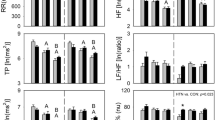Abstract
Amitriptyline (AT) increases sinus heart rate (SHR) due to inhibition of the reuptake of norepinephrine in combination with an antimuscarinic blockade of cardiac vagal inhibition. After 150 mg/day AT for 28 days, the change in SHR was negatively correlated with age in 42 depressed patients who were 18–85 years of age. This finding is consistent with observations that the tachycardic response to antimuscarinics and catecholamines decreases with aging.
Similar content being viewed by others
References
Baldessarini RJ (1980) Drugs and the treatment of psychiatric disorders. In: Gilman AG, Goodman LS, Gilman A (eds) The pharmacological basis of therapeutics. Macmillan, New York, pp 391–447.
Baldessarini RJ (1982) Overview of recent advances in antidepressant pharmacology: Part II. McLean Hospital J 7:1–27
Dauchot P, Gravenstein JS (1971) Effects of atropine on the electrocardiogram in different age groups. Clin Pharmacol Ther 12:274–280
Feighner JP (1981) Clinical efficacy of the newer antidepressants. J Clin Psychopharmacol (Suppl) 1:23–26
Glassman AH, Bigger JT (1981) Cardiovascular effects of therapeutic doses of tricyclic antidepressants: A review. Arch Gen Psychiatry 38:815–820
Guarnieri T, Filburn CR, Zitnik G, Roth GS, Lakatta EG (1980) Contractile and biochemical correlates of β-adrenergic stimulation of the aged heart. Am J Physiol 239:501–508
Hamilton M (1967) Development of a rating scale for primary depressive illness. Br J Soc Clin Psychol 6:278–296
Lakatta EG, Gerstenblith G, Angell CS, Shock NW, Weisfeldt ML (1975) Diminished inotrophic response of aged myocardium to catecholamines. Circ Res 36:262–267
Nies A, Robinson DE, Friedman MJ, Green R, Cooper TB, Ravaris CL, Ives JO (1977) Relationship between age and tricyclic antidepressant plasma levels. Am J Psychiatry 134:790–793
Snyder SH, Yamamura HI (1977) Antidepressants and the muscarinic acetylcholine receptor. Arch Gen Psychiatry 34:236–239
Veith RC, Bloom V, Bielski R, Friedel RO (1982) ECG effects of comparable plasma concentrations of desipramine and amitriptyline. J Clin Psychopharmacol 2:394–398
Yin FC, Spurgeon HA, Raizes GS, Greene HL, Weisfeldt ML, Shock NW (1976) Age-associated decrease in chronotropic response to isoproterenol. Circulation 54:II-167
Ziegler VE, Bun TE, Biggs JT (1977) Electrocardiographic findings in patients undergoing amitriptyline treatment. Dis Nerv Syst 38:697–699
Author information
Authors and Affiliations
Rights and permissions
About this article
Cite this article
Branconnier, R.J., Harto-Truax, N.E. & Cole, J.O. The effect of aging on the positive chronotropic response to amitriptyline. Psychopharmacology 82, 256–257 (1984). https://doi.org/10.1007/BF00427785
Received:
Accepted:
Issue Date:
DOI: https://doi.org/10.1007/BF00427785




